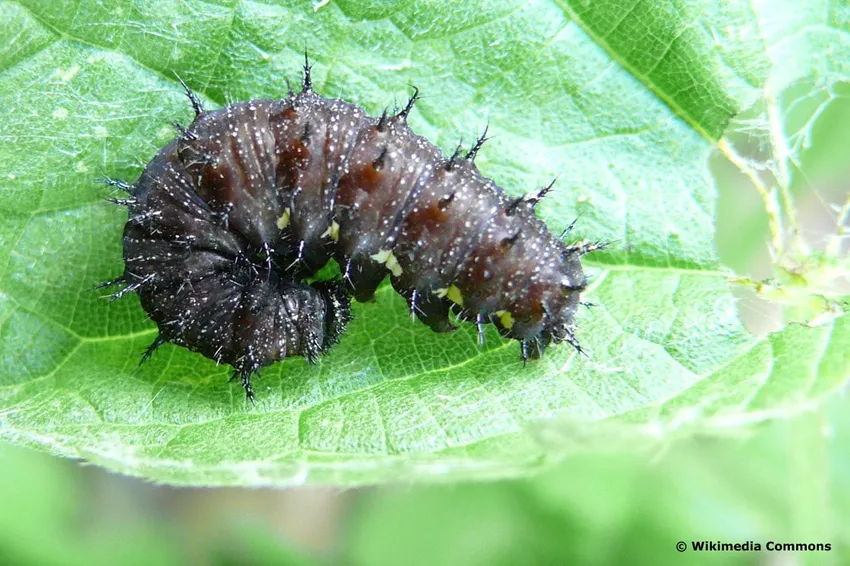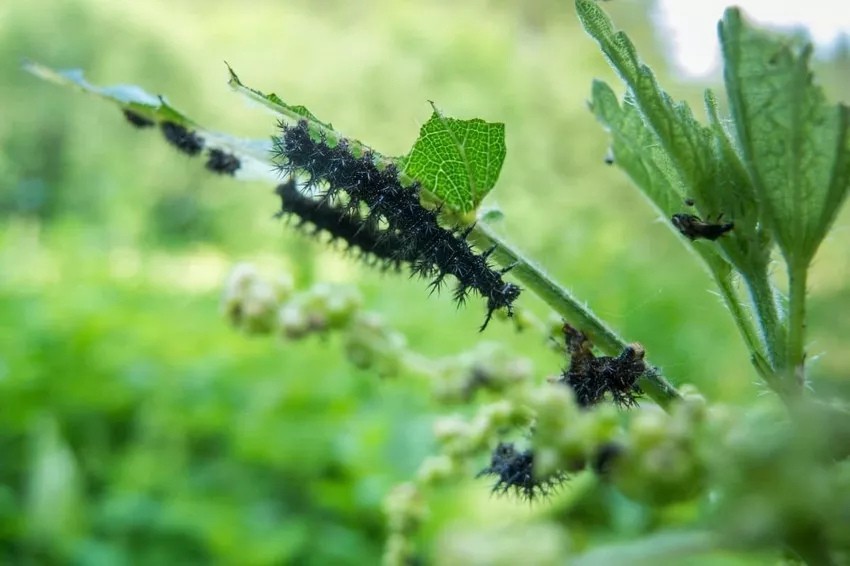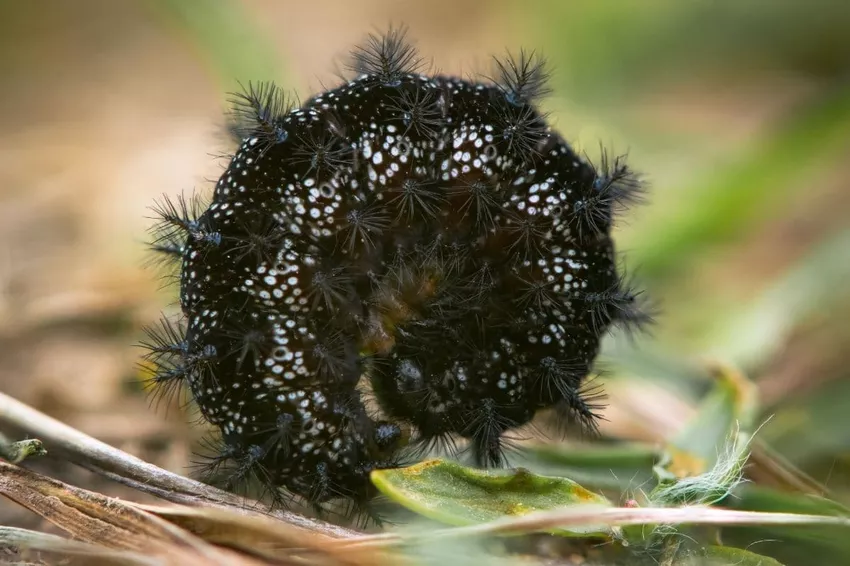
Different butterfly species have black colored caterpillars. In some species, the black coloring only shows up in a certain caterpillar stage. The dark color helps them to camouflage themselves or deter predators.
In a nutshell
- use distinctive features to identify caterpillars
- Caterpillars can vary in color at different stages
- among the owlet moths there are many species with black caterpillars
identify caterpillars
The easiest way to identify many butterfly species is through caterpillars. However, a striking number of native species have black caterpillars. Especially with black caterpillars you have to pay attention to the details.
The following characteristics are relevant for determination:
- age of the caterpillar
- hairiness
- spots or lines
- prominent extensions
- forage plant
While caterpillars within a given butterfly family do not have to be the same color, they can have similar characteristics. Therefore, knowing the characteristics of a butterfly family is helpful in identifying the caterpillars.
Notice: Caterpillars are very sensitive. You should not touch the insects to identify them.
butterfly
The noble butterflies (Nymphalidae) belong to the butterflies. The caterpillars of the moths usually have hair or even thorny or branched extensions, which makes them look very dangerous.
Admiral (Vanessa atalanta)
 Source: Harald Süpfle, Vanessa atalanta Raupe (HS), edited by Plantopedia, CC BY-SA 2.5
Source: Harald Süpfle, Vanessa atalanta Raupe (HS), edited by Plantopedia, CC BY-SA 2.5
- Caterpillar season: May - October
- Characteristics: grey-brown to black, thorny, light spots on the sides, spots may be absent
- Fodder plants: stinging nettle species, vitreous herb
Greater Fritillary (Speyeria aglaja)

- Caterpillar season: July - August
- Characteristics: black with reddish lateral rows of dots, black thorns with conspicuously long branches
- Fodder plants: violet species
Map (Araschnia levana)

- Caterpillar season: May - September
- Characteristics: Black with bleached sides and back stripes, tufted hair
- Fodder plants: nettles
Scabious Fritillary (Euphydryas aurinia)

- Caterpillar period: August (hibernation), late April - early May
- Characteristics: black with many small white spots, lighter vertical stripes
- Fodder plants: pigeon scabious, devil's bite, teasel family
Peacock butterfly (Aglais io)

- Caterpillar season: May (hibernation), July - August
- Characteristics: black with many white spots except in the head area, black spines
- Fodder plants: nettle
Owl moth
Within the owl moth family (Erebidae), there is great diversity in both butterflies and caterpillars. Some caterpillars of this genus even have extremely long hair, while others have poisonous stinging hairs.
Spring lichen bear (Eilema sororcula)
 Source: Ilia Ustyantsev, Eilema sororculum (larva) - Orange footman (caterpillar) - Лишайница золотистая (гусеница) (40154469784), edited by Plantopedia, CC BY-SA 2.0
Source: Ilia Ustyantsev, Eilema sororculum (larva) - Orange footman (caterpillar) - Лишайница золотистая (гусеница) (40154469784), edited by Plantopedia, CC BY-SA 2.0
- Caterpillar season: July - September
- Characteristics: black ground color with gray and white markings, reddish-brown warts, long sparse hairs
- Forage plants: lichens (mainly growing on deciduous trees)
Red-collared Lichen Bear (Atolmis rubricollis)
 Source: Ilia Ustyantsev, Atolmis rubricollis (larva) - Red-necked footman (caterpillar) - Лишайница красношейная (гусеница) (39052654490), edited by Plantopedia, CC BY-SA 2.0
Source: Ilia Ustyantsev, Atolmis rubricollis (larva) - Red-necked footman (caterpillar) - Лишайница красношейная (гусеница) (39052654490), edited by Plantopedia, CC BY-SA 2.0
- Caterpillar season: August - September
- Characteristics: dark gray to black basic color, marbled yellowish, reddish point warts with tufts of hair
- Forage plants: Lichens growing on deciduous and coniferous trees, mainly yellow lichen
Ruddy kitty owl (Orthosia miniosa)
 Source: Fabio Stergulc, Università di Udine, Bugwood.org, Orthosia miniosa larva, edited by Plantopedia, CC BY 3.0 US
Source: Fabio Stergulc, Università di Udine, Bugwood.org, Orthosia miniosa larva, edited by Plantopedia, CC BY 3.0 US
- Caterpillar season: May - June
- Characteristics: only black when young, later yellow-black longitudinal stripes, hairy
- Fodder plants: oaks, hawthorn
Satellite winter owl (Eupsilia transversa)
 Source: Ilia Ustyantsev from Russia, Eupsilia transversa (larva) - The Satellite (caterpillar) - Совка воинственная (гусеница) (41078543102), edited by Plantopedia, CC BY-SA 2.0
Source: Ilia Ustyantsev from Russia, Eupsilia transversa (larva) - The Satellite (caterpillar) - Совка воинственная (гусеница) (41078543102), edited by Plantopedia, CC BY-SA 2.0
- Caterpillar season: May - June
- Characteristics: black-brown or black with a slight violet tint, lighter top and side lines
- Fodder plants: Aspen, Sal willow, hazel, common beech, English oak
Sloe brush moth (Orgyia antiqua)
 Source: Slimguy, Orgyia antiqua Eiraupe 1, edited from Plantopedia, CC BY 4.0
Source: Slimguy, Orgyia antiqua Eiraupe 1, edited from Plantopedia, CC BY 4.0
- Caterpillar period: May (hibernation), late July - August
- Characteristics: only black when young, noticeably long hair, later red and black patterned segments on the back
- Fodder plants: blackthorn, hawthorn, raspberry, rowan, sal willow
Lovely bear (Callimorpha dominula)

- Caterpillar season: autumn (wintering) - June
- Characteristics: dark gray to black with yellow stripes and white spots down the side, black hair
- Fodder plants: raspberry, sal willow, hazel, nettle, plantain
Plantain bear (Arctia plantaginis)
 Source: James Lindsey at Ecology of Commanster, Parasemia.plantaginis.caterpillar, edited by Plantopedia, CC BY-SA 3.0
Source: James Lindsey at Ecology of Commanster, Parasemia.plantaginis.caterpillar, edited by Plantopedia, CC BY-SA 3.0
- Caterpillar season: August - May (overwintering)
- Characteristics: black-grey, black and fox red densely hairy
- Fodder plants: plantain species, dandelion, sorrel
White tiger moth (Spilosoma lubricipeda)
 Source: James Lindsey at Ecology of Commanster, Spilosoma.lubricipeda.caterpillar, edited by Plantopedia, CC BY-SA 3.0
Source: James Lindsey at Ecology of Commanster, Spilosoma.lubricipeda.caterpillar, edited by Plantopedia, CC BY-SA 3.0
- Caterpillar season: July - September
- Characteristics: dark gray to black, with reddish dorsal stripes, heavy dark brown to black hairs
- Fodder plants: dandelion, nettle, alfalfa, bugloss, plantain, blackberry, raspberry
Cluck
Within the butterfly family of the hens (Lasiocampidae), many colors are represented in the caterpillars. In addition to black specimens, there are also brown or variegated caterpillars with turquoise stripes. Mother hens get their name because the adult moths in the sleeping position look like hens protecting the chicks beneath them. They are active at dusk or at night and are easy to observe in artificial light. The caterpillars are usually specialized on certain food sources, which is often eponymous for a species. However, they can also become pests when they appear en masse at their food sources.
Bramble Moth (Macrothylacia rubi)

- Caterpillar season: April - September
- Characteristics: almost completely black when young, later black ground color with bright yellow or orange horizontal stripes, increasingly brownish with age, hairy
- Fodder plants: blackberries, sloes, raspberries, clover, vetch
Notice: Contact with the hair of the blackberry moth can cause an allergic reaction.
Hawthorn moth (Trichiura crataegi)
 Source: J. Pohjoismäki, Trichiura crataegi larva, edited from Plantopedia, CC0 1.0
Source: J. Pohjoismäki, Trichiura crataegi larva, edited from Plantopedia, CC0 1.0
- Caterpillar season: May - July
- Characteristics: black to brownish coloration with yellow segments, warts on the back, irregularly haired
- Forage plants: hawthorn, birch, oak, willow
Stretcher
The locomotion form of the caterpillars gives the family of the moths (Geometridae) their name. Due to the few pairs of legs, the caterpillars move as if they were stretching themselves out again and again.
Bilberry moth (Hydriomena furcata)
 Source: Patrick Clement from West Midlands, England, 70.074 BF1777 July Highflyer, Hydriomena furcata, larva (9101573334), edited by Plantopedia, CC BY 2.0
Source: Patrick Clement from West Midlands, England, 70.074 BF1777 July Highflyer, Hydriomena furcata, larva (9101573334), edited by Plantopedia, CC BY 2.0
- Caterpillar season: April - early July
- Characteristics: dark gray to black coloration, white side stripes
- Fodder plants: blueberry, sal willow, hazel, roses
During the day, the caterpillars of the blueberry palm moth spin shoot tips or leaves together, in which they rest.
frequently asked Questions
What do I do if I come into contact with a hairy caterpillar?Not all hairy caterpillars cause an allergic reaction. If you have not been able to clearly identify the caterpillar, wash the affected area and observe it. If the reaction is severe, see a doctor.
Can black caterpillars appear in groups?Yes, the caterpillars of the peacock butterfly, for example, can appear in large groups. When overwintering in the caterpillar stage, some species also form nests together.
Can thorny appendages also be poisonous?Thorny appendages only serve to deter predators. Compared to the hair, these extensions cannot be poisonous.